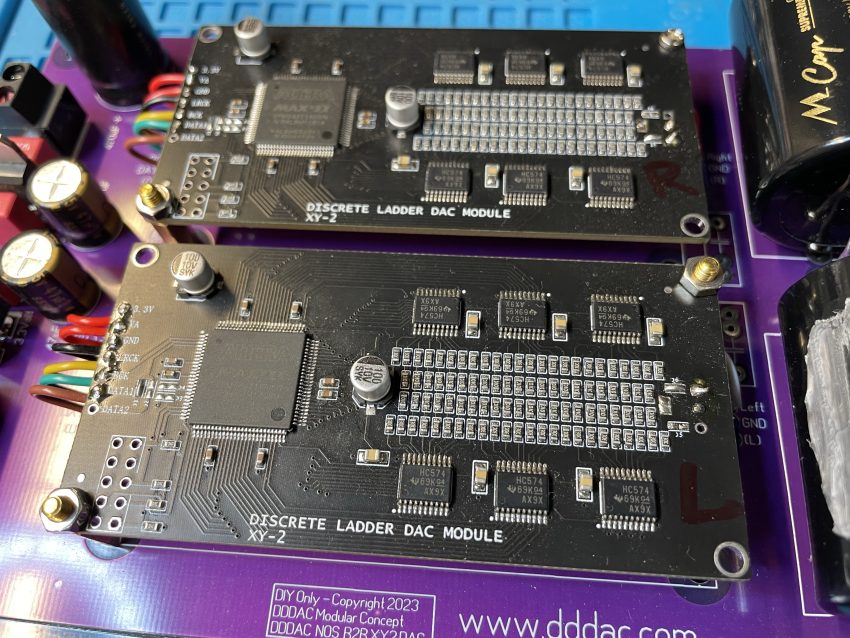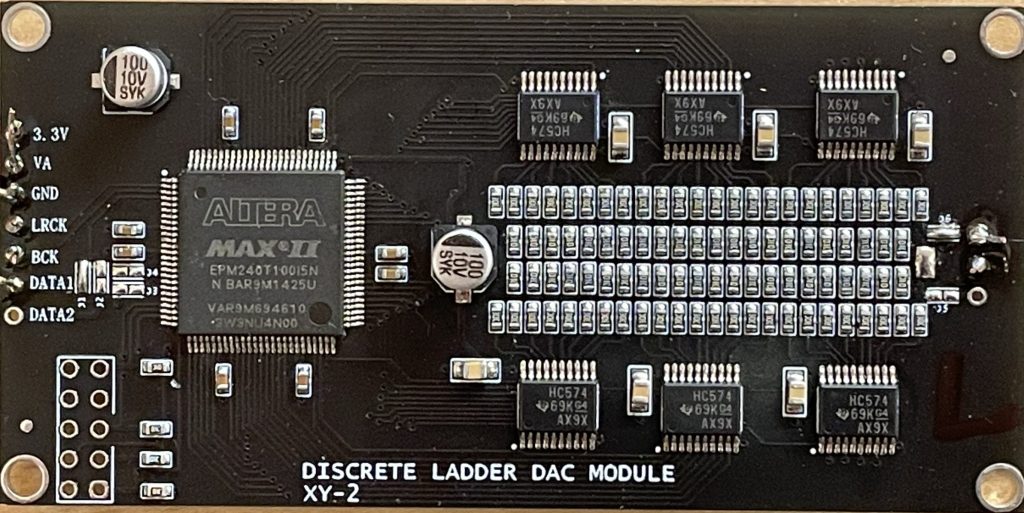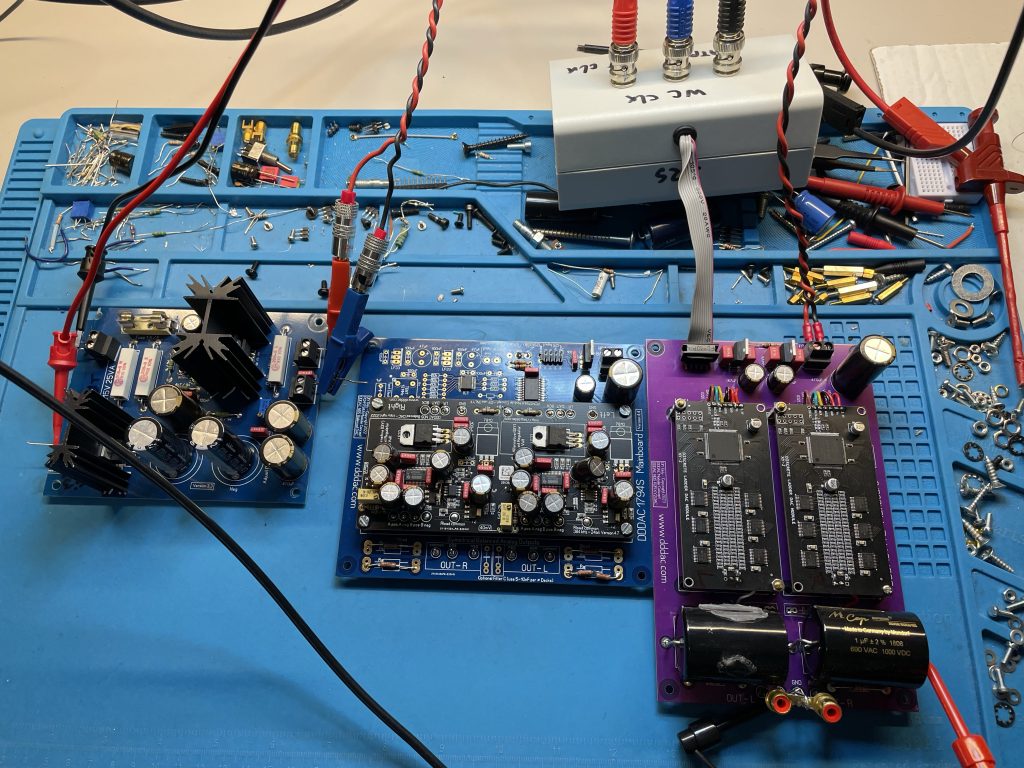
Experiments with a discrete R2R ladder DAC (XY2)
Introduction
It is in the name DDDAC… I have spent so many years on DACs, it was about time to follow up on my curiosity on R2R ladder DACs. Not the ones inside a chip – we know them well in the meantime – but the discrete ones. A decade or so ago, very rare. But in recent times they pop up everywhere. All of them looking pretty much the same: A balanced resistor ladder network and a piece of logic (ASIC in most cases and some 8 channel D-FLIP FLOPs) converting the digital signal into analog. All built up like a “24-bit-DAC”.
This probably has always been the BIG question, how “24-bits” are they really? Remember laser trimmed chips to get to a certain level of bits? I read about DIY boards where thousands of resistors were bought to hand select up to 0,001 % matching (like 16 bits…) Others offer boards with a choice of 0,02% or 0,01% resistors. Sounds like resolution of 12-14 bits? To be very honest, I did not go into the math and physics on what % matching you need for real 24 bits but somehow, I still do not think 24 bits is possible, not even 16 bits. But that is just a personal hunch to be very clear and honest. Till the point I measure it myself…
OK, I did not want to spend aver 500 Euro just for the fun of trying one. So, the whole topic was at rest kind of. Until I found these on Ali for like 60 Euro each. Specification sounded “very good” – But all electronics on Ali is described as “high-End of course, LOL. Anyway, the concept is the same so let’s try this…
Ali Express XY2 R2R DAC…
This what the Ali-seller claims:
“The design scheme refers to the ROCKNA complementary design and compensation algorithm, which aims to solve the sound distortion caused by zero-crossing distortion and resistance accuracy. The actual test effect is more effective than the ordinary scheme. Support format: PCM 24-bit” – LOL

Creating a Carrier Board for this R2R DAC

The boards need some settings, input connectors, output capacitors and two power supplies. I did not want to make wild bunch of wires and loose components around it. So I quickly sketched a carrier PCB. As you can see it is based on the mainboard topology of the DDDAC1794 series. So, design was done on a rainy Sunday afternoon. With this I could connect a DDDAC Power supply and a WaveIO Board and start listening. Comparision with the DDDAC1794 was planned of course. Source and power supply would be at least the same (and hence being a fair comparison)
Time to start listening (after a few days of burn-in)
Listening Impressions
I will not go into the long detailed proza as in most audio magazines. Just very simple impression after putting on some music.
First impression:
Oh, nice… It does sound very “analog” – I do get the same feel and look (or hear) when listening to my DDDAC1794 DAC. Open, wide and deep stage. Natural sounding Instruments and voices. Not “Bad at All” for this price.
Second impression:
After a couple of tracks and listening for some time, it becomes very apparent, that the DAC is lacking micro detail. You can hear this on voices and acoustical Instruments which are lacking as I call “texture”. And worse is the typical listening fatigue coming from the not clear highs. It is not precise and sounds harsh compared to the DDDAC1794. not smooth at all, especially in a high-resolution system as I have (Horns and 300B SE amplifiers)
Final “ordeal”:
As a second DAC in my office or in my workshop? yes why not. Of course, I have DDDAC1794 leftovers in there, but it is by means of speaking.
It seems that the CONCEPT of this DAC is right. It does show potential in the holographic and natural sound.
For real high-end music joy, it is absolutely lacking precision, low level detail and smooth highs.
Measurements (with my AP-System two)
The previous experiences called for some 1:1 comparison measurement with my AP gear. Is it distortion? Is it linearity (lack of effective bits?) With the AP SIA2322 Interface I can output any signal in the form of an I2S signal (see the small grey box) feeding the DAC. The analog output can be read by the AP to create any sweep I want to see if I could find a reason for the lack of detail and harsh highs.

First, I tested the linearity of both DACs. It starts at the right side of the scale with a signal level representing 0 bits under full scale output. The signal is then reduced in steps of one bit and the output level is measured. This should result in a straight line of course. The point where the line starts showing irregularities or is not following the lower output of the signal, we reached the point where a signal with more bit depth does not result in a corresponding signal output.
AS you clearly see in the graph below. The DDDAC1794 is linear up to 20 bits (which is VERY good) – by the way: sneak preview: The new DDDAC1794KM3 prototype board actually went on linear up to -23 bits for low frequencies….) At higher frequencies the last bits get buried a bit in quantization noise.
The XY-2 DAC is NOT linear anymore after already 11 bits. It also has a strange effect on low frequencies below 12 bits before noise kicks in. I believe this explains it all….

I did a similar measurement with the decreasing signal level in bits from 0 bit till -12 bit, measuring the THD+Noise. This is roughly the linear region of the DAC. See below graph for the results. Already below -5 bits distortion+noise is above 1%. Most music tracks are rather playing in the region up to this level, so I am not impressed by this result.

Conclusions
- This anecdotical review and test show (for me) there is potential of discrete R2R ladder DACs.
- Why on earth install 24 “bits” of resistors when only 12 are effective? They seem to be bottleneck…
- Conclusion seems to be justified that when the resistors are not extremely matching, results cannot live up to the datasheet specifications.
- The sound concept is nice. Analog feeling comes up and is close to the DDDAC1794.
- But not when it comes to low level detail, distortion and smooth highs.
- For a cheap DAC or experiments? why not…
What next?
To be honest, I would like to write a follow up with a “really good” R2R ladder DAC which claims to have gotten it right in terms of matching resistors.
Anyone out there who would be willing to lend me their R2R DAC for listening comparison and the exact same AP System Two tests?
That would be great! Just write me an E-Mail!
7 thoughts on “Experiments with a discrete R2R ladder DAC (XY2)”
Fascinating experiment. I hope someone sends you an example of a well regarded resistor DAC.
If your test shows two DACs with similar results on these tests, do they sound similar? Or is an ESS chip still going to have a different subjective signature than an R2R based chip.
Have you ever done this test with a TDA1541A based DAC? I clearly prefer the subjective sound of their double crown S2. These are just standard chips that happen to test well coming off the fab. Presumably just slightly better resistor values. It also would be interesting to see the extent to which implementation choices impact the bit depth and distortion tests.
Hi Walter,
Now you are asking the right question. No, they do not sound the same at all. Just think of I/V stages being different, Algorithms inside the chip, Digital filtering or not etc. Personally, I do not like the ESS sound at all. Not analog and too flat and uninvolving. For example, the TDA1543 (my old NOS DDDAC1543 series) sounds also very analog, but more brute force and direct mids as the DDDAC1794, which sounds more refined so to speak.
yep, hope to get another DAC for a fair 1:1 comparison!
Czy moduły testowane były z sygnałem i2s 352kHz ? Jak wyglądają pomiary dla wyższych częstości próbkowania.
No, I did not, as the AP digital output goes up to 48kHz. I do not expect that it will be any better at higher FS though. rather worse to be honest.
By the way, try to write English, so it is easier for other readers to Foll wo
Hello
I asked because the NOS mode measurements are very poor for this type of R2R ladder. Above a frequency of 10 kHz are very bad. It’s completely different for OS mode (for example, measurements posted on the ASR website).
Sorry, I wrote with the online translator turned on.
Thanks Krzysztof,
do you have a more specific link to ASR where this is discussed or showed?
Right now, I cannot grap why linearity would be better at higher sample Frequencies.
As for the NOS mode, it affects all R2R at higher frequencies.
As for linearity, I don’t think it will have any effect. I’m just curious.
This may have a significant impact on the level of distortion.